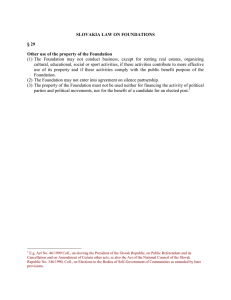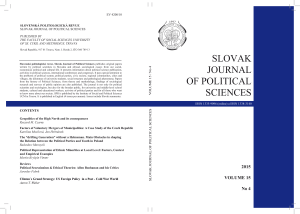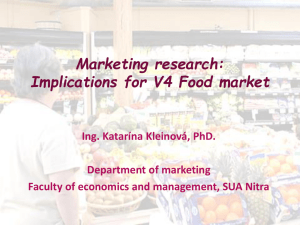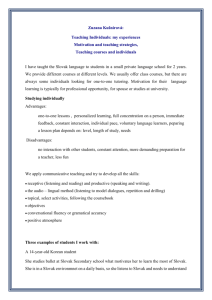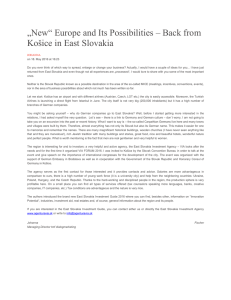Challenges and Best Practices of Hospitability and
advertisement
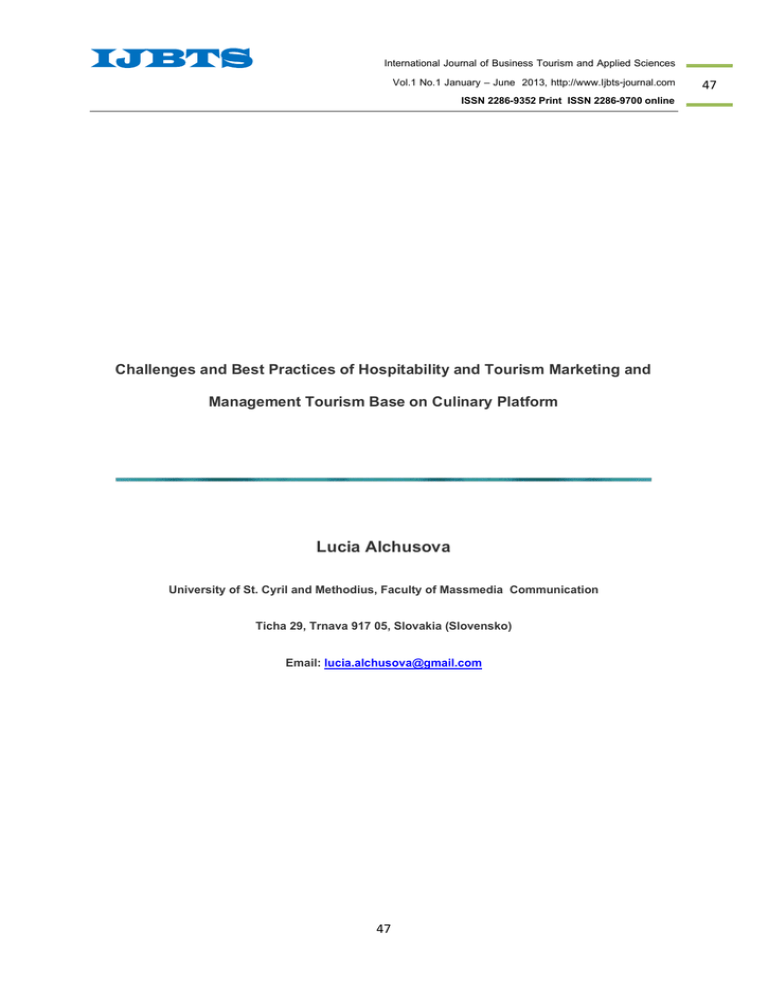
IJBTS International Journal of Business Tourism and Applied Sciences Vol.1 No.1 January – June 2013, http://www.Ijbts-journal.com ISSN 2286-9352 Print ISSN 2286-9700 online Challenges and Best Practices of Hospitability and Tourism Marketing and Management Tourism Base on Culinary Platform Lucia Alchusova University of St. Cyril and Methodius, Faculty of Massmedia Communication Ticha 29, Trnava 917 05, Slovakia (Slovensko) Email: lucia.alchusova@gmail.com 47 47 IJBTS International Journal of Business Tourism and Applied Sciences Vol.1 No.1 January – June 2013, http://www.Ijbts-journal.com ISSN 2286-9352 Print ISSN 2286-9700 online Challenges and Best Practices of Hospitability and Tourism Marketing and Management Tourism Base on Culinary Platform Lucia Alchusova University of St. Cyril and Methodius, Faculty of Massmedia Communication Ticha 29, Trnava 917 05, Slovakia (Slovensko) Email: lucia.alchusova@gmail.com ABSTRACT The dynamics of this period is reflected in the cuisine and the associated tourism. Fast food chains use different marketing strategies to gain customers and also to prosper economically. Slow Food, it's more than just a movement, it's more than just food. His primary goal: to protect traditional, local food, culture preserve food, its preparation and dining. In short fights against globalization and the giant food chain that radically blurred the specificity of national cuisines. This movement is also present in Slovakia. The situation in Slovakia is currently such that Slovak producers trying to convince the customer to buy domestic products. Slovaks must again learn to eat what is typically Slovak. In Italy is all based on tourism. The model we should adopt in Slovakia and learn to offer what we have at home. Create specifics home hospitality and favorable conditions for the opening of the culinary tourism platform. Here, Slovaks ranked among other countries, in addition to mountains, sea, lakes, history, build their tourism and the culinary experiences. Offer tourists what they can not experience elsewhere. It's a business opportunity for a small family business. First, the present and build your name, then mark the region. 1. SLOW FOOD VS. FAST FOOD 21st century has not been nicknamed, yet. Mankind is coming to a crossroad offering various possibilities.The dynamics of time is reflected also in gastronomy and tourism. Fast food chains have been using various marketing strategies to attract more customers and the same time to insure economic prosperity of their company. We dare say that Peltzman effect is valid in this field, too. This phenomenon is so pervasive that it has been named after the University of Chicago economist who first discovered it in 1975. The Peltzman effect explains that if a new regulation imposes restrictions on people's behavior, then people 48 48 IJBTS International Journal of Business Tourism and Applied Sciences Vol.1 No.1 January – June 2013, http://www.Ijbts-journal.com ISSN 2286-9352 Print ISSN 2286-9700 online find ways to follow the new law but also change their behaviour in such a way that the net effect of the regulation is null. Petltzman effect can be seen in marketing of fastfood as well. In 2009, in Journal of Consumer Research was published a highly interesting study in which The KFC and McDonald’s offered not only fried chicken nuggets but also healthy salads. During the experiment customers were offered two menus. The first menu consisted of chicken nuggets and French fries or fried potato wedges, the second menu offered the same but with a salad. The study showed that majority of customers were in favour of the second menu but more than 90% of them selected French fries within the menu. Kieth Wilcox from Baruch College proves salad ‘to be healthy’, so when customer takes a salad, it lowers his inner inhibitions thus he selects something unhealthy to treat himself. It is called a compensative action. A fresh and healthy salad completely dissolves fat, and is satisfying, but as soon as people realise it they start to behave differently [ they treat themselves with junk food].Fast Food Chains are delighted because they have managed to subside the pressure of health experts and offer healthy food which does not substitute unhealthy food. What is more, it increases the sale of it. Dieticians count on Slowfood ,established by Carlo Petrini in Italy, in 1986. Slowfood is defined as foodstuff produced from regional ingredients and processed traditional ways. Slowfood is more than just food, it is a movement with primary objectives to protect traditional, local food, and to preserve food culture especially meal preparation and eating customs. In brief, Slowfood fights the food globalization and fast food chains that radically eliminate particularities of national cuisines. Slowfood movement operates in Slovakia, too. It helps to promote local fruit and vegetable, traditional diary and meat products, traditional wines, aperitif and digestive drinks. Slowfood operates in Poland as well where it increases the quality of traditional Polish meals and food, but does not combat fast food culture. Its primary objective is to increase the quality of traditional food processing, foodstuff itself. Slowfood movement comprises of several convivio which associate people who are interested in regional and culinary heritage, traditional food products and food processing. Each convivio organises local or regional activities to promote traditional food processing and food culture. SLOW FOOD IN EU Well developed EU countries like Italy or France have already adopted Slowfood philosophy as one of the marketing strategy for a regional and small family business. The companies that followed Slowfood 49 49 IJBTS International Journal of Business Tourism and Applied Sciences Vol.1 No.1 January – June 2013, http://www.Ijbts-journal.com ISSN 2286-9352 Print ISSN 2286-9700 online philosophy had to subordinate business image, design, culture and their label. Their marketing effort, in competitive struggle must have been much higher because it takes more time and effort to get customers. WHAT IS THE SITUATION IN SLOVAKIA LIKE? Slovak producers are trying to persuade customers to buy Slovak products because Slovak consumers are not used to it. They think what is imported is of higher quality. Without thinking they reach for products made in Poland, Germany, China, or Brazil. On the other hand, shops do not offer enough Slovak products, but imported once because they are much cheaper thus more acceptable for consumers. We dare to say that there are very few Slovak products in shops. The Slovaks are not patriotic like the Italians or the French. The quality of products is directly proportional to the price. Slovak producers warn about lower quality of some imported products. Food experts advise Slovak consumers to buy Slovak products as these products are of high quality which is checked several times and not only while processing. To increase the sale of Slovak products, a project called the Quality from Our Regions, is run by the Ministry of Agriculture and Rural Development of the Slovak Republic and the Ministry of Economy of the Slovak Republic. The main objective of the above mention project is to educate consumers and to enhance cooperation of all market participants. The project coordinator is the Confederation of Trade Unions of the Slovak Republic which is responsible for creating activities to increase the number of Slovak products in shops. The following are the project objectives : a) b) c) d) e) f) g) h) i) Educate citizens to gain economic knowledge to help them make better macroeconomic shopping decisions Explain consumers how economics works and how they can get involved in the improvement of the quality of life of the society they are part of Support selling and buying products produced in the regional market Explain the general public why it is beneficial for them to buy products either grown or produced in the national region Influence buying behaviour and stabilise consumer habits beneficial for regional products and national market Stabilise and support internal market demand Support producers, products and retailers in regions Create conditions to improve supplier-customer relationships Support employment through producing regional products 50 50 IJBTS j) International Journal of Business Tourism and Applied Sciences Vol.1 No.1 January – June 2013, http://www.Ijbts-journal.com ISSN 2286-9352 Print ISSN 2286-9700 online Support national pride by building affinity to regional products and respect of one´s own work and work of other citizens 1.1. QUALITY FROM OUR REGIONS“ Recent surveys show that the number of Slovak products bought by younger Slovaks has significantly decreased. Moreover, majority of young Slovaks do not feel patriotic. To change the unwilling buying behaviour of Slovaks it is inevitable to educate them and communicate with them. The project called ‘the Quality from Our Regions’ is not the first attempt, in 2009 a campaign called ‘Nakupujme doma’ (shop at homecountry) was run to increase the sale of traditional regional products in Slovakia. ‘The Quality from Our Regions’ is not just a one year project but it is elaborated for longer period. One of the project objectives is to support employment through producing regional products as there is significant lack of qualified employees in food processing and selling. Thus this project is run with a close cooperation with the Ministry of Education. Another important project objective is to support national pride and respect of one’s own work and work of other citizens. Slovaks should be proud of their national cuisine and food and they should get used to eating their traditional regional food like the Italians ,who are so proud of their pasta, pizza, regional cheeses, and wines, do. Moreover, the Italian cuisine with its typical food and products help to increase tourism in their regions. This Italian model could be adopted also in Slovakia. Slovaks should learn to offer and sell the products that are processed in Slovakia, doing so they could create specifics of Slovak hospitability and favourable conditions for travel and tourism based on gastronomy. Succeeding this, Slovakia would rank among countries that apart from their natural beauties and rich history build their travel and tourism on gastronomic experience. The Slovak gastronomy can be experienced through wine routes, visits of shepard’s chalets, plaiting fresh cheese whips, cooking little cheese dumplings and processing homemade precooked sausages. Slovak traditional cuisine has a lot of uniqueness to offer to tourists. This may be an excellent opportunity for Slovak family businesses and their marketing strategies. Small family businesses could promote themselves and build their reputation which later could represent a trademark. Succeeding in this, they would be able to represent their region and to offer tourists something unique and traditional the same time, so typical of Slovakia. Slovaks are said to be very hospitable. The traditional symbol of Slovak hospitability is bread and salt that is offered to every visitor. However, this habit was neglected by communist regime in the 2nd half of the 20th century 51 51 IJBTS International Journal of Business Tourism and Applied Sciences Vol.1 No.1 January – June 2013, http://www.Ijbts-journal.com ISSN 2286-9352 Print ISSN 2286-9700 online 1.2 MADE IN SLOVAKIA Within ‚the Quality from Our Regions‛ project new logo ‚Made in Slovakia‛ was introduced to make it easier for customers to recognise products that have been made in Slovakia. What can the logo ‘Made in Slovakia’ offer to global trade? Any product that is of high quality, unique, ecologically friendly, competitive, and processed Slovak traditional technology. Global trading means that for example a diary product called’ Slovak sheep cheese ‘which is a product of Liptov diary company, thus typically Slovak, though the majority of shareholders is the French diary concern called Bongrain. ‚Made in Slovakia‛ logo is seen on the cream cheese called ‚Karička‛ that have been produced in Slovakia for 30 years. Slovak sheep cheese is well known and is protected with the geographical indication. Majority of Slovak cheese producers manufacture sheep and cow milk the traditional technology whether processing unsmoked or smoked cheese. For smoking cheese, beech wood is used and no additives or preservatives are added. Products made in Slovakia always come with the attribute Slovak or other geographical indication thus they all are protected. (for example Slovak sheep cheese, Slovak parenica cheese, Trnava mead, Trenčin honeywine.) 1.2. TRADEMARK OF QUALITY SK (ZNAĆKA KVALITY) ‚Značka kvality sk ‚ (trademark of quality sk) which has been running since 2004, is another national project to support the sale of Slovak agricultural products. The project objective is to promote products manufactured in Slovakia highlighting their quality and origins thus enhancing product competitiveness. Every year producers have opportunities to apply at The Ministry of Agriculture and Rural Development for the logo ‚Značka kvality sk‛. Figure 1: Trademark of quality SK (značka kvality) 52 52 IJBTS International Journal of Business Tourism and Applied Sciences Vol.1 No.1 January – June 2013, http://www.Ijbts-journal.com ISSN 2286-9352 Print ISSN 2286-9700 online Awarded products must be proved in above standard qualities and guarantee high quality characteristics in comparison with similar products. Another condition is whether manufacturing the products follows strict technological processes declared in national and European legislative. Moreover, the declaration of the used ingredients origin is absolutely inevitable and the final product must contain 75% of domestic ingredients and all phases of manufacturing are done in Slovakia. The more Slovak products are popular with sellers and consumers, the more approachable they become to tourists. Trade and tourism in Slovakia is going its own way, respecting that the Slovak Republic is an agricultural country which have realised that the best for Slovak economy, trade and tourism is going back to its roots, the roots that are based on domestic high quality ingredients and traditional manufacturing processes. BIBLIOGRAPHY 1. Clow, E., Baack, D. (2008), Reklama, propagace a merketingová komunikace. Brno: Computer Press, a.s. 2. 3. 4. 5. 6. 7. 8. 9. 10. Kretter, A. (2004), Marketing. Nitra: SPU. Matúš, J. a kol. (2008), Marketing – základy a nástroje. Pirasová, C. (2008), Culinaria Italia, Praha: Slovart, s.r.o. Matúš, J. (2005), Základy marketingu a marketingovej komunikácie. Trnava: FMK UCM. Vopílenský, J. (2006), Stručný slovník masmediálnej a marketingu. Trnava: FMK UCM. Sakál, P. (2007), Strategický manažment v praxi manažéra. Trnava: SP SYNERGIA. Železný, V. (2010), Dobré rady milovníka vína. Mladá fronta. Tomcyk-Miczka, E. (2007), Malopolska- palce lizac. Krakow: Malopolska Organizacja Turysticzna. Tomcyk-Miczka, E. (2009), Malopolska trasa smakoszy (Gourmet routes in Malopolska). Krakow: MOT. 53 53
